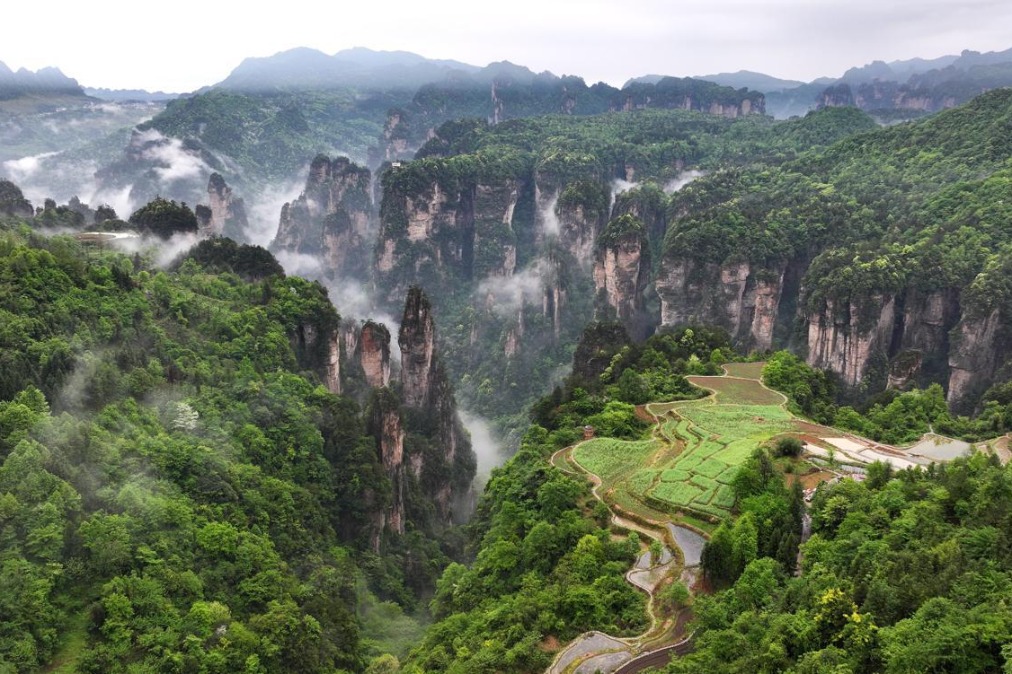Volcanic park boosts tourism in Haikou


The Haikou Volcanic Cluster Global Geopark in Hainan province is carving out a new model for eco-tourism by blending world-class geological heritage with agricultural innovation, hands-on education and rural vitalization.
Home to 40 dormant volcanoes, more than 30 lava tunnels and millenniums-old geological relics, the park has become a magnet for scientists, cyclists and international travelers. Its 222.8-meter peak anchors a 108-square-kilometer landscape that ranks among China's top ecological destinations.
In February, young cyclists from Zhuhai, Guangdong province, pedaled through the park's lush terrain as part of a 350-kilometer journey across eastern Hainan.
Coach Cang Er, who led the group, called the geopark's vegetation a "living specimen wall" for students. Participants explored a 69-meter-deep crater and learned how the volcano's roots stretch 2,000 km beneath the Earth's surface.
Cyclist Zhu Zhengyi described the view as a "rare combination of ancient stone and greenery".
Cang suggested expanding the park and adding interactive learning features such as models of parasitic cones — small volcanoes located on the flanks of larger ones — and maze-like installations to enhance its educational function.
During his visit, Thomas Estley, a Belgian national living in Shanghai, praised the park's balance of preservation and accessibility.
"The mix of greenery and volcanic rock is something you won't see in Europe," he said, noting that the island's mild winters draw his family back every year. His son called the black volcanic rocks and crater formations "unlike anything in Europe".
Yang Guanxiong, a tourism geographer and former researcher at the Chinese Academy of Sciences' institute of geography, said, "The ecological features here are remarkable — tropical forests and diverse vegetation thrive atop ancient volcanic remains, with compositions and structures distinct from non-volcanic regions."
He added that the mineral-rich volcanic soil produces uniquely flavorful fruits and vegetables, and the area is home to the prized Shishan goat, offering a nutritious foundation for tourism, leisure and wellness industries, as well as scientific research.
That transformation did not happen overnight. Two decades ago, Shishan township struggled with poor soil and water shortages. Today, local staples include black beans, volcanic lychees, jackfruit and Shishan goat, which once sold for just 12 yuan ($1.64) per kilogram but can now fetch more than 130 yuan amid soaring demand.
Chen Yaojing, chairman of Hainan Yewan Group, spearheaded the park's development with a focus on ecological protection and sustainable growth.
More than 20 years ago, Chen registered the "Volcanic Lychee" brand, eventually building it into a nationally recognized product. Despite its commercial success, he donated the trademark to the local government to widen its benefits to farmers.
He also launched training programs to teach residents how to become restaurateurs, helping boost the number of Shishan goat eateries and tourism-related jobs. His initiatives allowed local crops to gain value through agro-tourism.
Today, many farmers in the area work across agriculture and hospitality sectors. The average annual income for local farmers has risen from less than 1,000 yuan in the 1990s to more than 20,000 yuan, according to Haikou's agriculture and rural affairs bureau.
"Volcanic tourism drives agricultural transformation, creates new professions and supports rural vitalization," Chen said.
Annual visitors to the geopark have surged from just 35,000 two decades ago to more than 1 million, transforming the once little-known geological site into a major eco-tourism destination.




































